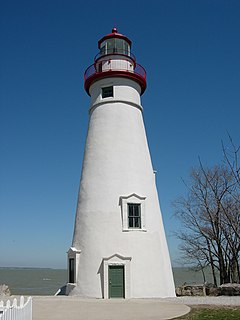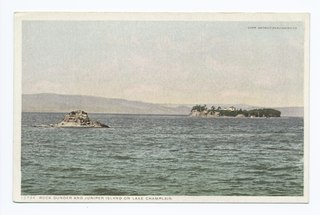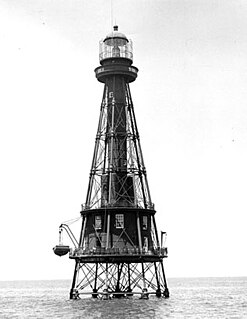
Marblehead Lighthouse in Marblehead, Ohio, United States, is the oldest lighthouse in continuous operation on the American side of the Great Lakes. It has guided sailors safely along the rocky shores of Marblehead Peninsula since 1822, and is an active aid to navigation.

The unmanned reef lights of the Florida Keys were navigational aids erected near the Florida Keys between 1921 and 1935. They were intended to mark local hazards and did not need to be visible for as far as the reef lights that were erected near the Keys during the 19th century. By the time the lights in this list were erected, older lighthouses were being automated, and these new lights were designed to be automated from the start. The lights resembled the older reef lights in having a wrought iron skeletal pyramidal structure on a screw-pile foundation. They all originally had lanterns on their peaks, so that they looked like smaller versions of the older reef lights, but had no keeper's quarters.

The New Presque Isle Light was built in 1870, at Presque Isle, Michigan, east of Grand Lake, and sits on the namesake peninsula. It is one of 149 lighthouses in Michigan, more than any other state. Because of changing shoreline particularly, or alternatively deterioration of the original building, it is not uncommon for a replacement lighthouse to be placed in the vicinity of an earlier light, in this case, the Old Presque Isle Light.

The Old Presque Isle Light was the first lighthouse in the Presque Isle, Michigan area, built in 1840, supported physically by two-thirds stone and one-third brick, and supported financially by funds appropriated by Congress two years earlier of $5,000. The tower and dwelling did not last long in the harsh weather, however, and by 1867 they were deteriorated enough for Congress to find need for a newer station. It presently is not operational and is a museum.

Brant Point Light is a lighthouse located on Nantucket Island. The station was established in 1746, automated in 1965, and is still in operation. The current tower was added to the National Register of Historic Places on October 28, 1987; it has the distinction of being the tenth light on the point, in addition to several range lights. Four of the others burned or blew down, two were condemned, two were unsatisfactory, and the remaining one stands unused.

The first Saginaw River lighthouse was constructed from 1839 to 1841, in a period when large quantities of lumber were being harvested and shipped from the heart of Michigan via river and the Great Lakes to the East Coast of the United States via the Erie Canal and Hudson River. This connection to major eastern markets was critical to the development of central Michigan.
The Windmill Point Light in Vermont is the northernmost lighthouse on Lake Champlain. Extinguished for seventy years, it was reactivated in 2002 to replace the skeleton tower erected next to it.

The Crown Point Light on Lake Champlain is a former lighthouse at Crown Point, New York, that now exists as a memorial to the exploration of the lake by Samuel de Champlain.

The Marquette Harbor Light is located on Lake Superior in Marquette, Michigan, a part of the Upper Peninsula. It is an active aid to navigation.

The Rock of Ages Light is a U.S. Coast Guard lighthouse on a small rock outcropping approximately 2.25 miles (3.62 km) west of Washington Island and 3.5 miles (5.6 km) west of Isle Royale, in Eagle Harbor Township, Keweenaw County, Michigan. It is an active aid to navigation.

The Cove Island Light, at Gig Point on the island, is located in Fathom Five National Marine Park, but is not part of the Park. It is situated on the Bruce Peninsula, Ontario Canada. It has been a navigational aid in the narrow channel between Lake Huron and Georgian Bay since 30 October 1858. It was the first of six stone Imperial Towers to be completed; all were illuminated by 1859. Most other lighthouses of the era were built of brick, wood, iron or concrete.

The Juniper Island Light on Juniper Island in Vermont is the oldest light station on Lake Champlain and the oldest surviving cast iron lighthouse in the United States.

The Colchester Reef Light in Vermont was a lighthouse off Colchester Point in Lake Champlain. It was moved to the Shelburne Museum in Shelburne, Vermont, in 1956.

The Indiana Harbor East Breakwater Light is an active aid to navigation that marks the end of a breakwater on the east side of the Indiana Harbor and Ship Canal where it enters Lake Michigan.

Juniper Island is a 13-acre (53,000 m2) island in Lake Champlain, approximately 3.15-mile (5.07 km) southwest of Burlington, Vermont's King Street Ferry Dock. The island is home to the Juniper Island Lighthouse. The State of Vermont purchased the island for $200 in 1825 and ceded it to the federal government. A 30-foot (9.1 m) brick tower and keeper's house were constructed. Up to that point, lanterns hung on trees by landowners up and down the lake had served navigation; this would be the first true lighthouse on the lake.

Little River Light is a lighthouse on an island at the mouth of the Little River, in Cutler, Maine. A light station was first established at this site in 1846, and the present structure was built in 1876. It is one of the only iron lighthouses in the state, and was listed on the National Register of Historic Places as Little River Light Station on March 14, 1988. The light station is now owned by the American Lighthouse Foundation, which offers overnight stays in the keeper's house, and occasional tours of the property.

Rawley Point Light is a lighthouse located in Point Beach State Forest, near Two Rivers, Wisconsin. At 111 feet (34 m) tall, it is the tallest lighthouse on the Wisconsin Shore and it is listed on the National Register of Historic Places.

The Ship Shoal Light is a screw-pile lighthouse located in the Gulf of Mexico southwest of the Isles Dernieres off the coast of Louisiana. It is currently abandoned.

The South Fox Island Light was a light station located on South Fox Island in the north end of Lake Michigan. There are two towers standing at the site: the first is the original brick keeper's house and tower, while the second is a skeletal tower moved to this site from Sapelo Island, Georgia in 1934. Neither is operational. The station was listed on the National Register of Historic Places in 2021.

The St. Joseph North Pier Inner and Outer Lights are lighthouses in Michigan at the entrance to the St. Joseph River on Lake Michigan. The station was built in 1832 with the current lights built in 1906 and 1907; they were decommissioned in 2005.



















